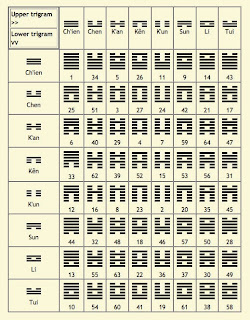
I Ching is built of linear signs represented by 64 sets composed of two three-line arrangements, namely hexagrams (guà) that represent sixty four main kinds of life situations. The lines of hexagram are, of course, not just lines. Each hexagram has a name and is a physical symbol representing deeply metaphysical or subconscious manifestation. Every line of hexagram can be broken or unbroken. The unbroken or solid line represents yang, the ‘creative’ principle. The broken or open line with a gap in the centre represents yin, the ‘receptive’ principle. These principles are also represented in a common circular symbol or diagram known as Tai Chi Tú but more commonly known in the West as the yin-yang symbol, expressing the idea of wholeness of constantly undergoing change.
 Traditionally the I Ching is consulted by throwing 50 yarrow stalks, but today a set of three coins is used more frequently. When a hexagram is cast using one of the traditional processes of divination with I Ching, each yin and yang line will be indicated as either moving (changing), or fixed (unchanging). A second hexagram is created by changing moving lines to their opposite and represents new possibilities and transition that might occur due to someone’s interaction of a free will.
Traditionally the I Ching is consulted by throwing 50 yarrow stalks, but today a set of three coins is used more frequently. When a hexagram is cast using one of the traditional processes of divination with I Ching, each yin and yang line will be indicated as either moving (changing), or fixed (unchanging). A second hexagram is created by changing moving lines to their opposite and represents new possibilities and transition that might occur due to someone’s interaction of a free will.Richard Wilhelm’s translation of the Book of Changes explains that the book is not just a theory of ideas. Besides in-built change it also comprises a free will of a person inquired. In this way one can make himself independent of the tyranny of events. The I Ching evolved through the millenniums. The need for greater differentiation seems to have been felt at an earlier date, and the single lines were combined in pairs. Then later on the third line was added. This brought the eight trigrams into existence and was conceived as images of all that happens in Heaven and Earth. At the same time, they were held to be in a state of continual transition, one changing into another.

Combining a rigorously consistent, dualistic yin-yang doctrine with the doctrine of the ‘five stages of change’ (the five element processes, phases, or steps) taken from the Book of History are deeply rooted in Chinese tradition. Five ‘elements’ or rather processes are wood, fire, earth, metal and water. Hence the Tai Chi Quán set is sometimes called the thirteen techniques.
Nearly all that is greatest and most significant in the three thousand years of Chinese cultural history has either taken its inspiration from this book, or has exerted an influence on the interpretation of its text. Therefore it may safely be said that Lǎo Zǐ knew the book and some of his profoundest aphorisms were inspired by it. Confucius too knew this book and by reflecting upon it he developed greatly. The Confucius text edited and annotated by him that has come down to our time is why it is considered that he probably wrote down some of his interpretative comments and imparted others to his pupils in oral teaching. Both philosophers developed their work (Daoism and Confucianism) around it. Emperors and dynasties like The Ch'in and Han followed it as a Chinese philosophical thinking. That is why also martial arts could not be an exception and to understand the philosophy behind one should have the knowledge about the Book of Changes.

No comments:
Post a Comment
Note: Only a member of this blog may post a comment.